Mårten Wadenbäck
Radially Distorted Homographies, Revisited
Aug 28, 2025Abstract:Homographies are among the most prevalent transformations occurring in geometric computer vision and projective geometry, and homography estimation is consequently a crucial step in a wide assortment of computer vision tasks. When working with real images, which are often afflicted with geometric distortions caused by the camera lens, it may be necessary to determine both the homography and the lens distortion-particularly the radial component, called radial distortion-simultaneously to obtain anything resembling useful estimates. When considering a homography with radial distortion between two images, there are three conceptually distinct configurations for the radial distortion; (i) distortion in only one image, (ii) identical distortion in the two images, and (iii) independent distortion in the two images. While these cases have been addressed separately in the past, the present paper provides a novel and unified approach to solve all three cases. We demonstrate how the proposed approach can be used to construct new fast, stable, and accurate minimal solvers for radially distorted homographies. In all three cases, our proposed solvers are faster than the existing state-of-the-art solvers while maintaining similar accuracy. The solvers are tested on well-established benchmarks including images taken with fisheye cameras. The source code for our solvers will be made available in the event our paper is accepted for publication.
DaD: Distilled Reinforcement Learning for Diverse Keypoint Detection
Mar 11, 2025Abstract:Keypoints are what enable Structure-from-Motion (SfM) systems to scale to thousands of images. However, designing a keypoint detection objective is a non-trivial task, as SfM is non-differentiable. Typically, an auxiliary objective involving a descriptor is optimized. This however induces a dependency on the descriptor, which is undesirable. In this paper we propose a fully self-supervised and descriptor-free objective for keypoint detection, through reinforcement learning. To ensure training does not degenerate, we leverage a balanced top-K sampling strategy. While this already produces competitive models, we find that two qualitatively different types of detectors emerge, which are only able to detect light and dark keypoints respectively. To remedy this, we train a third detector, DaD, that optimizes the Kullback-Leibler divergence of the pointwise maximum of both light and dark detectors. Our approach significantly improve upon SotA across a range of benchmarks. Code and model weights are publicly available at https://github.com/parskatt/dad
DeDoDe: Detect, Don't Describe -- Describe, Don't Detect for Local Feature Matching
Sep 03, 2023



Abstract:Keypoint detection is a pivotal step in 3D reconstruction, whereby sets of (up to) K points are detected in each view of a scene. Crucially, the detected points need to be consistent between views, i.e., correspond to the same 3D point in the scene. One of the main challenges with keypoint detection is the formulation of the learning objective. Previous learning-based methods typically jointly learn descriptors with keypoints, and treat the keypoint detection as a binary classification task on mutual nearest neighbours. However, basing keypoint detection on descriptor nearest neighbours is a proxy task, which is not guaranteed to produce 3D-consistent keypoints. Furthermore, this ties the keypoints to a specific descriptor, complicating downstream usage. In this work, we instead learn keypoints directly from 3D consistency. To this end, we train the detector to detect tracks from large-scale SfM. As these points are often overly sparse, we derive a semi-supervised two-view detection objective to expand this set to a desired number of detections. To train a descriptor, we maximize the mutual nearest neighbour objective over the keypoints with a separate network. Results show that our approach, DeDoDe, achieves significant gains on multiple geometry benchmarks. Code is provided at https://github.com/Parskatt/DeDoDe
RoMa: Revisiting Robust Losses for Dense Feature Matching
May 24, 2023Abstract:Dense feature matching is an important computer vision task that involves estimating all correspondences between two images of a 3D scene. In this paper, we revisit robust losses for matching from a Markov chain perspective, yielding theoretical insights and large gains in performance. We begin by constructing a unifying formulation of matching as a Markov chain, based on which we identify two key stages which we argue should be decoupled for matching. The first is the coarse stage, where the estimated result needs to be globally consistent. The second is the refinement stage, where the model needs precise localization capabilities. Inspired by the insight that these stages concern distinct issues, we propose a coarse matcher following the regression-by-classification paradigm that provides excellent globally consistent, albeit not exactly localized, matches. This is followed by a local feature refinement stage using well-motivated robust regression losses, yielding extremely precise matches. Our proposed approach, which we call RoMa, achieves significant improvements compared to the state-of-the-art. Code is available at https://github.com/Parskatt/RoMa
Deep Equivariant Hyperspheres
May 24, 2023Abstract:This paper presents an approach to learning nD features equivariant under orthogonal transformations for point cloud analysis, utilizing hyperspheres and regular n-simplexes. Our main contributions are theoretical and tackle major issues in geometric deep learning such as equivariance and invariance under geometric transformations. Namely, we enrich the recently developed theory of steerable 3D spherical neurons -- SO(3)-equivariant filter banks based on neurons with spherical decision surfaces -- by extending said neurons to nD, which we call deep equivariant hyperspheres, and enabling their stacking in multiple layers. Using the ModelNet40 benchmark, we experimentally verify our theoretical contributions and show a potential practical configuration of the proposed equivariant hyperspheres.
TetraSphere: A Neural Descriptor for O(3)-Invariant Point Cloud Classification
Nov 26, 2022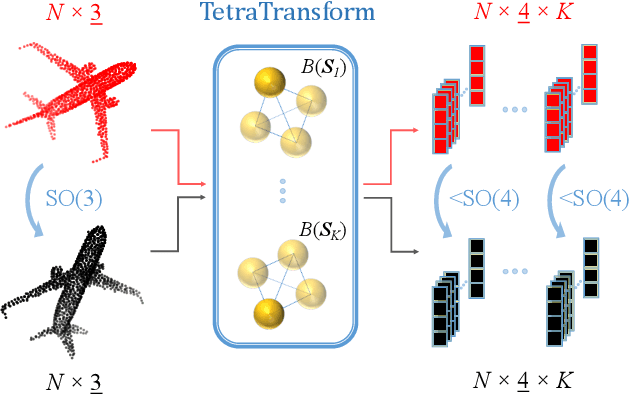
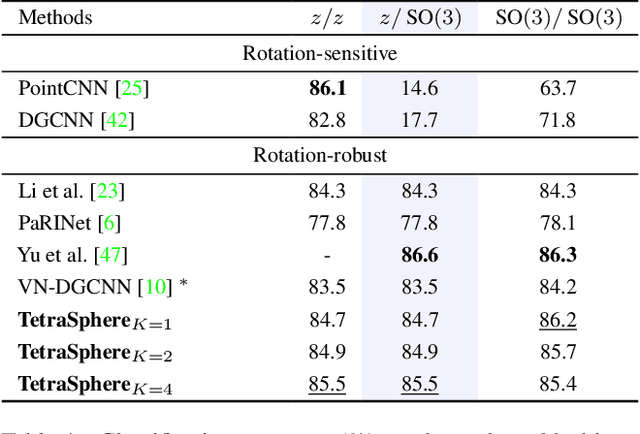

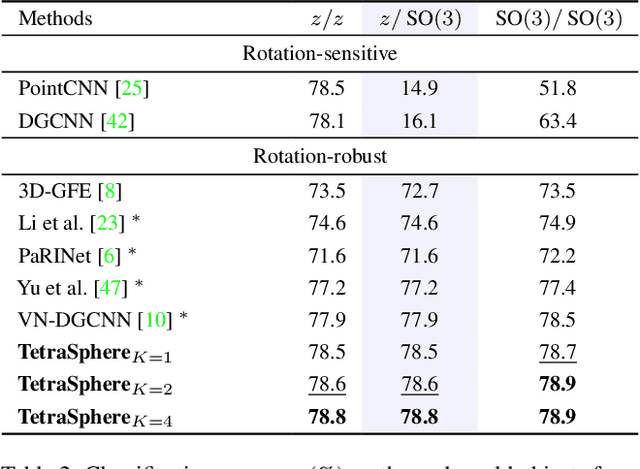
Abstract:Rotation invariance is an important requirement for the analysis of 3D point clouds. In this paper, we present TetraSphere -- a learnable descriptor for rotation- and reflection-invariant 3D point cloud classification based on recently introduced steerable 3D spherical neurons and vector neurons, as well as the Gram matrix method. Taking 3D points as input, TetraSphere performs TetraTransform -- lifts the 3D input to 4D -- and extracts rotation-equivariant features, subsequently computing pair-wise O(3)-invariant inner products of these features. Remarkably, TetraSphere can be embedded into common point cloud processing models. We demonstrate its effectiveness and versatility by integrating it into DGCNN and VN-DGCNN, performing the classification of arbitrarily rotated ModelNet40 shapes. We show that using TetraSphere improves the performance and reduces the computational complexity by about 10% of the respective baseline methods.
Deep Kernelized Dense Geometric Matching
Feb 01, 2022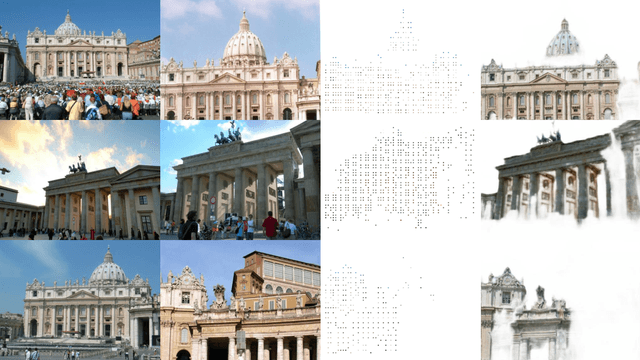
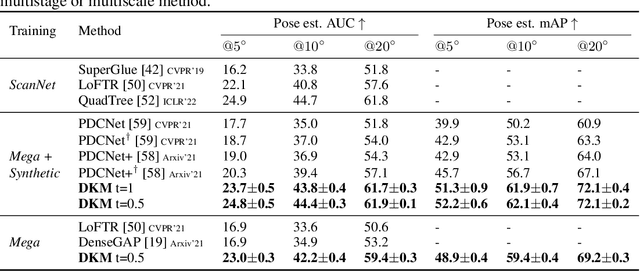


Abstract:Dense geometric matching is a challenging computer vision task, requiring accurate correspondences under extreme variations in viewpoint and illumination, even for low-texture regions. In this task, finding accurate global correspondences is essential for later refinement stages. The current learning based paradigm is to perform global fixed-size correlation, followed by flattening and convolution to predict correspondences. In this work, we consider the problem from a different perspective and propose to formulate global correspondence estimation as a continuous probabilistic regression task using deep kernels, yielding a novel approach to learning dense correspondences. Our full approach, \textbf{D}eep \textbf{K}ernelized \textbf{M}atching, achieves significant improvements compared to the state-of-the-art on the competitive HPatches and YFCC100m benchmarks, and we dissect the gains of our contributions in a thorough ablation study.
Trust Your IMU: Consequences of Ignoring the IMU Drift
Mar 16, 2021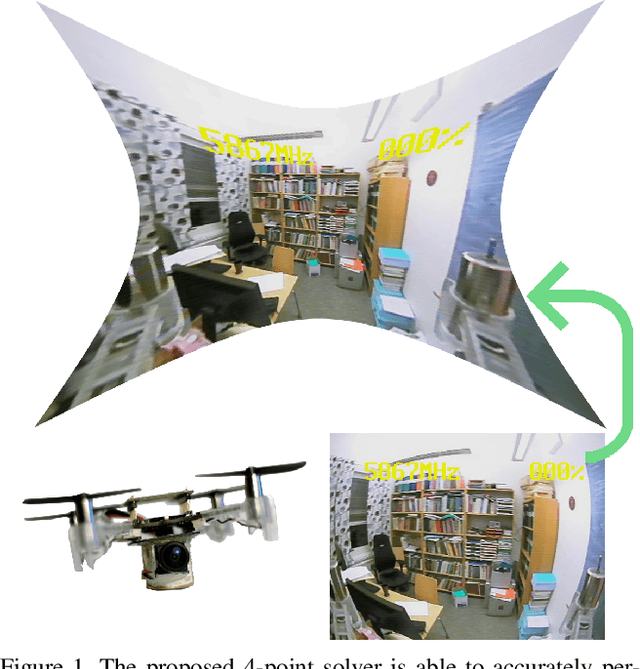



Abstract:In this paper, we argue that modern pre-integration methods for inertial measurement units (IMUs) are accurate enough to ignore the drift for short time intervals. This allows us to consider a simplified camera model, which in turn admits further intrinsic calibration. We develop the first-ever solver to jointly solve the relative pose problem with unknown and equal focal length and radial distortion profile while utilizing the IMU data. Furthermore, we show significant speed-up compared to state-of-the-art algorithms, with small or negligible loss in accuracy for partially calibrated setups. The proposed algorithms are tested on both synthetic and real data, where the latter is focused on navigation using unmanned aerial vehicles (UAVs). We evaluate the proposed solvers on different commercially available low-cost UAVs, and demonstrate that the novel assumption on IMU drift is feasible in real-life applications. The extended intrinsic auto-calibration enables us to use distorted input images, making tedious calibration processes obsolete, compared to current state-of-the-art methods.
Efficient Real-Time Radial Distortion Correction for UAVs
Oct 08, 2020
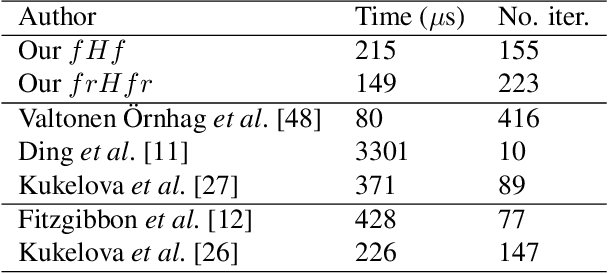
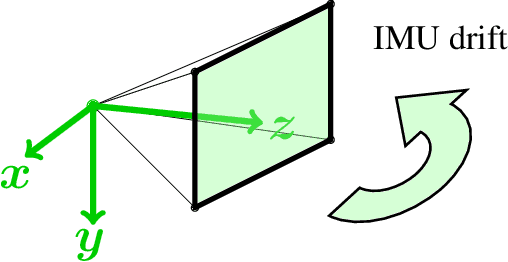

Abstract:In this paper we present a novel algorithm for onboard radial distortion correction for unmanned aerial vehicles (UAVs) equipped with an inertial measurement unit (IMU), that runs in real-time. This approach makes calibration procedures redundant, thus allowing for exchange of optics extemporaneously. By utilizing the IMU data, the cameras can be aligned with the gravity direction. This allows us to work with fewer degrees of freedom, and opens up for further intrinsic calibration. We propose a fast and robust minimal solver for simultaneously estimating the focal length, radial distortion profile and motion parameters from homographies. The proposed solver is tested on both synthetic and real data, and perform better or on par with state-of-the-art methods relying on pre-calibration procedures.
Embed Me If You Can: A Geometric Perceptron
Jun 11, 2020



Abstract:Solving geometric tasks using machine learning is a challenging problem. Standard feed-forward neural networks combine linear or, if the bias parameter is included, affine layers and activation functions. Their geometric modeling is limited, which is why we introduce the alternative model of the multilayer geometric perceptron (MLGP) with units that are geometric neurons, i.e., combinations of hypersphere neurons. The hypersphere neuron is obtained by applying a conformal embedding of Euclidean space. By virtue of Clifford algebra, it can be implemented as the Cartesian dot product. We validate our method on the public 3D Tetris dataset consisting of coordinates of geometric shapes and we show that our method has the capability of generalization over geometric transformations. We demonstrate that our model is superior to the vanilla multilayer perceptron (MLP) while having fewer parameters and no activation function in the hidden layers other than the embedding. In the presence of noise in the data, our model is also superior to the multilayer hypersphere perceptron (MLHP) proposed in prior work. In contrast to the latter, our method reflects the 3D-geometry and provides a topological interpretation of the learned coefficients in the geometric neurons.
 Add to Chrome
Add to Chrome Add to Firefox
Add to Firefox Add to Edge
Add to Edge